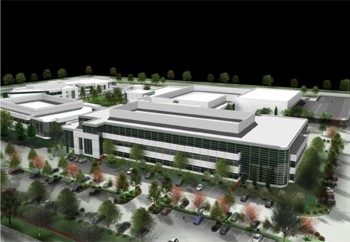Roche Diagnostics Breaks Ground on New Research Facility
Roche Diagnostics Breaks Ground on New Research Facility

Alameda and Pleasanton Research Groups to be Combined in New Building
Roche Diagnostics has broken ground on a new research facility at 4320 Hacienda Drive. Pleasanton is Roche's regional headquarters and R&D center for molecular diagnostics. Its research groups are presently split between Pleasanton and Alameda. The three-story, 135,238 square foot new building will allow Roche to consolidate its research groups in one building while providing needed expansion space for other departments.
The first two floors will provide the laboratories and office spaces for the research groups led by Walter Koch, Ph.D, head of Research, comprising core research, core chemistry, human genetics, infectious diseases, pharmacogenomics, and R&D services. Koch notes that there are a number of benefits in addition to bringing his teams together under one roof and in the same location as the rest of Roche Molecular Diagnostics on the West Coast. Pleasanton serves as the business headquarters.
"Just as important is the synergy with our development colleagues and the rest of the organization," Koch says. "We interface directly with Development because they take our prototypes and develop them further, both analytically and clinically for ultimate FDA registration for manufacturability. We also interface very closely with our Business Development and Marketing colleagues, as well as Licensing and Regulatory and other functions. Just having all of us in one site makes a tremendous difference."
Besides the research groups, the building will also house the Chief Technology Office, and Legal and Licensing as well as a training/conference area and a full-service cafeteria.
One of the main features of the new building, and the Roche campus, is that it is designed in accordance with the U. S. Green Building Council's LEED (Leadership in Energy and Environmental Design) Green Building Rating System, a voluntary, consensus-based national standard for developing high-performance, sustainable buildings.
The facility features a low pressure drop heating/cooling system that will require less energy to operate. A cool-roof design using a highly reflective and high emissivity coating on the roof to reduce the heat absorbed by the building as well as emitted from the surface to the surrounding area. A water-efficient landscape plan features drought-tolerant plants and below-ground irrigation to reduce evaporative loss.
Another area in which Roche's new building excels in sustainable design is the use of recycled materials in building products such as carpet, ceiling tiles, and wood. Material from pre-construction demolition is recycled, not sent to a landfill.
"We integrated sustainable design and energy conservation ideas during the early phases of the design," says Greg Canfield, senior director of Facilities Management. "As we considered these ideas, there was an incremental cost. We used a life cycle approach that included the initial cost plus the operating cost over a period of time to determine whether we wanted to proceed with these ideas or not. And although we incurred about $300,000 in incremental cost to the project, we get that paid back in less than a year upon operation."
The new research building is scheduled for completion in February 2008 with an initial occupancy of about 200 employees, bringing the Roche Pleasanton campus to about 600 employees. Roche Diagnostics is a part of F. Hoffmann-La Roche Ltd, founded in Basel, Switzerland in 1896. The division employs 20,000 people worldwide.
Also in this issue...
- Roche Diagnostics Breaks Ground on New Research Facility
- Sub-One Technology Moves Headquarters to Hacienda
- Business Bits
- Executive Profile: Nelson Hunter Puts His Finance Background to Good Use in the Commercial Travel Industry
- RossMorgan & Associates Makes Small Size Work in Big Ways
- J. Travis Photography Brings Digital Workflow to Product Promotion
- Business Support Organizations Offer Both Local, Regional Focuses for Increasing Their Members' Success
- Looking for IT Info, Education, Camaraderie? Try EBIG
- Hacienda Conducting Survey to Determine Transit Needs, Future Solutions
- Hope Hospice offers In-Home Care and Additional Services for Those at the End of Life
- Commuter Choice Transportation Fair
- Hacienda Index
- Calendar




